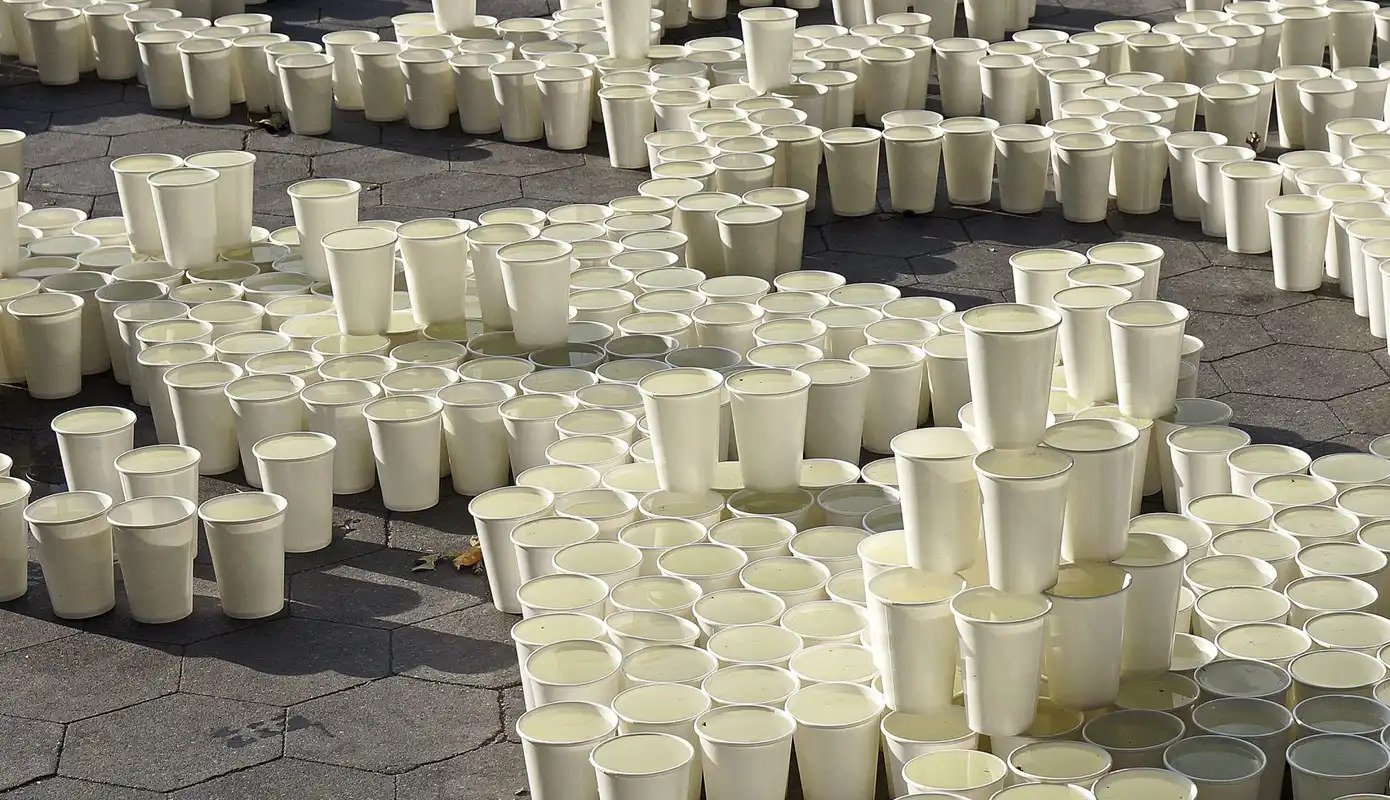A week before the installation, I am a nervous wreck.
I’ve gotten into many heated arguments about “memorializing terrorists” in New York City. I am worried about the safety of myself and of the friends who have agreed to help build the piece. Washington Square Park is haunting me. I sit in there for hours watching traffic patterns, the random waves of people that pass through the plaza. I watch New Yorkers for signs, trying to see if the war is in them. I start to worry it is. Maybe all this calm, this bourgeois relaxation is just an illusion. What will happen if I disrupt it? Will all hell break loose? And if it does, is that what I want?
Every day I am trying to research. The more I research, the less I understand. I don’t know if I am contributing to these lost lives at all. I have never met these people, nor will I ever meet them. I have no Somali or Yemeni friends. I have not helped with any anti-war or anti-drone petitions. I remind myself this is not a research paper, it is an art installation; I do not have to cite my sources. I am speaking as who I am: a white passing Mexican girl from California, who has never experienced war, but is overcome by a need to act. That’s all I can claim. It may not be good, but it is honest.
The night before the installation I work on my artist’s statement. I have slept a total of six hours in the past two days. Around 10:30 it is done. I fall, heavy and nervous, into sleep.
In the morning I rise and make coffee. My hands shake. Our filmmaker Charlie and my good friend Shireen arrive around 5:30. We struggle to strap ladders onto the roof, to fit 2,500 cups into the car. The sun is rising. We set off, the Williamsburg Bridge becoming bathed in light.
We unload and begin. For the first few hours most people ignore us. Some read our signs then continue on with no expression. There are only a couple of hundred cups out at this point; I think this is why no one cares. A journalist for Al-Arabiya passes on her morning jog and takes an interest. I am thrilled that anyone stops at all. One man talks with me at great length, thanking me for creating the piece.
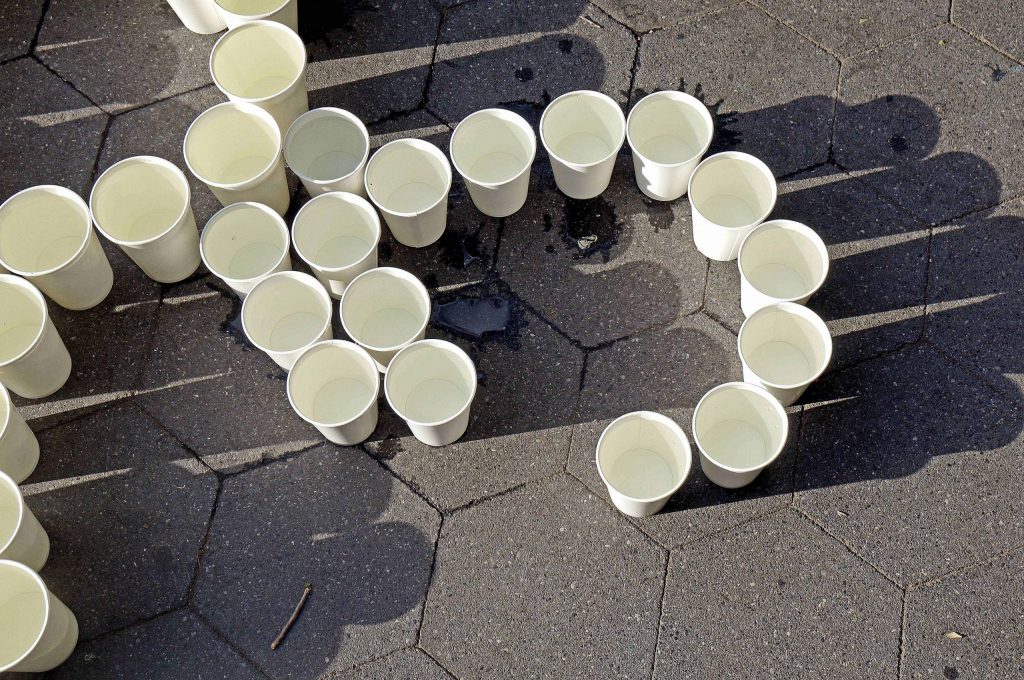
At around 8:30 am, we receive our first critic, a man who draws hearts and claims to be the most famous artist in the world. “That’s cool,” I say. “No,” he says, “cool is a temperature.”
He tells me we are focusing too much on negativity and that negativity breeds more negativity, and this is why his art is so much better than mine. He says we must “ignore negativity”. I try and point out that you cannot “ignore negativity” when you’re the target of a drone strike. “How old are you anyways?” he asks.
“Twenty-two,” I reply.
“Ah,” he says, “you can’t see it now but when you’re older you will. Your art is good, but if you want to be truly great, you have to ignore the bad shit, like me.”
At that moment a large gust of wind blows a stack of my artist’s statements around the plaza. “That was an act of god!” he shouts.
Before he leaves, he draws two hearts on the ground with chalk. As the exhibit grows cups are placed over them. Water spills and the heart’s borders warp eventually becoming unrecognizable.
The labor of filling up the cups is surprisingly meditative. My friends and I chatter and joke as we work. I haven’t seen many of them in months, the sun is shining, and we are becoming a young community of artists. We have purpose, and momentum. We are happy.
Still, in the back of my mind, it strikes me as strange, the joy emanating from us. We are representing people murdered by our government. We are laughing and enjoying ourselves. I know imposing a fake solemnity would be absurd and offensive, so instead I focus on being honest. This is what is happening now. A hang.
Around 9:30 am, the first stranger joins our group: a young boy named Miguel, a junior in high school.
He was sitting by the statue watching and reading a book for an hour, then eventually came over and asked what we were doing. Later I look up to see him fetching water from the fountain. I thank him for his help and he stays a few hours. When I have a free moment I talk to him, we joke about how he’s supposed to be in class. He tells me it’s a free period. I don’t know if he is lying or not, but I don’t care.
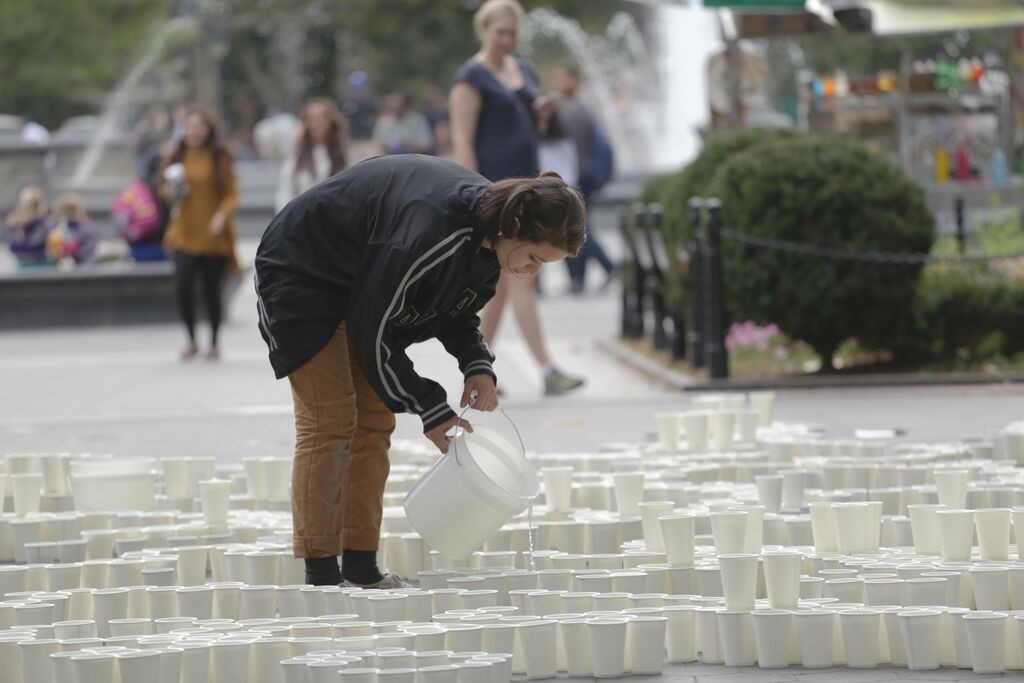
The exhibit is growing now. It’s 11am and we still haven’t finished the first thousand. The interest is growing too. Barely two minutes pass without someone wanting to speak with me. A drunk veteran who fought in Iraq talks with us for half an hour. His beer is leaking ever so slightly through the brown paper bag it’s hidden in, creating a dark stain. I watch it grow.
“Lieutenants, they don’t even know what’s happening, and the shit just trickles down,” he says. “And there are private contractors — everyone thinks it’s Haliburton, it’s not just Haliburton. It’s more than that, I don’t even know who. No one does… I’m saying too much but oh well.”
Part of becoming part of the park is talking to people you would normally avoid. The intention of this piece is to start a conversation, and we have an obligation to listen to everyone. An old white Irish man approaches us and starts yelling about dirty Muslims. I was expecting this. He doesn’t understand why we aren’t making art about the Christians killed by Muslims. We tell him this isn’t the purpose of the piece. He and the veteran get into an argument about something in military speak regarding rank — I don’t understand. He storms off, red in the face.
By 11am we have a crowd around us that will stay until 8pm. The flow of people comes and goes in waves. We find ourselves constantly surrounded by strangers. On a trip to the fountain Charlie says to me excitedly, “This is like a real art piece in New York City! People are actually paying attention!”
“I know,” I say. I can hardly believe it myself.
Every other minute someone stops me from whatever I am doing to “meet the artist”, talk to me about my intentions, influences, and surprisingly, a lot of the time, to congratulate me. Two people sit on a nearby statue and research facts on military drones. One student promises to bring their global politics class from NYU. There are people who ask me whether the death toll contains civilians or terrorists and when I reply both, their faces cloud over. “But aren’t there people who need to die? People we should be killing over there?” one man asks me. “This is an exercise in looking at the worth of human life” I reply. He walks away angry, unwilling to fight.
A middle aged woman comes up to me and asks if it’s true that drones kill people. “Yes,” I say. “I thought Amazon just used them to send packages,” she says, then she asks me what college I went to and if I would recommend it for her daughter.
Another woman tells me she can’t recall if she’s known an America that isn’t at war either. She must be in her mid-thirties. She looks to the man standing next to her for help: “Maybe in the eighties… Do you remember? Were we fighting anyone in the eighties?”
He shrugs and shakes his head. She tells me she waited so long to have a baby because she didn’t know what kind of world she would be bringing it into. Her gaze falls to the cups. “But now he’s here, and this is the world. So, I guess that’s it. He’s lives here now”
A young girl from Pakistan tells me the piece means a lot to her. We talk about the fact that my numbers seem low and I agree. “It was the best I could find,” I tell her.
As the sun warms the park and the installation grows, more and more strangers are joining in the setup of the cups. In a haze of exhaustion and shock I watch the piece being built.
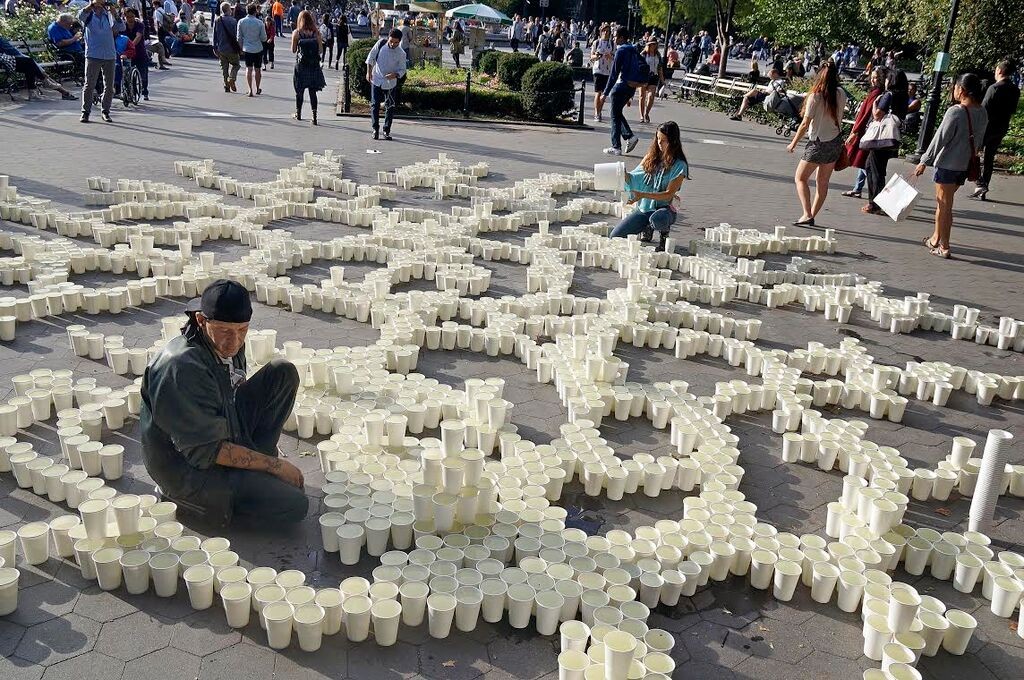
After hours of answering the same questions over and over again, I look up from my work with the cups to watch the New Yorkers. A blond white girl standing in the middle of the installation forces a smile for her blond white mother. She takes a picture. The mother instructs her how to pose and snaps another. I wonder where they will post these photographs, and what they will say:“And this is Jessica posing with 2,500 dead people,” then later, “and here we are at the Empire State Building.”
Children are running through the installation, playing in the cups. One by one, strangers infected with the “spirit of activism” courageously leave the crowd and get down on their hands and knees to help. At this point in the day, the exhibit is “cool” and the people who are working on it look the coolest of all. They photograph themselves working.
Everyone is smiling. Everyone is instagramming. People read the artist’s statement, they frown, they look upon what I now realize is a very beautiful installation in the middle of a beautiful park, and they relax and feel good. The sun is shining. It’s like being in the middle of a living, breathing, Humans of New York post.
I want to vomit.
I leave the park. It is the first time I have been alone all day. I find a bench and lie down. My eyes are starting to blur from exhaustion.
It is too late to change the installation. We have our beautiful white cups. We have our beautiful water and our clear blue sky shimmering on its surface. We have our goddamn yuppie audience, relaxing and feeling cultured and righteous. There is no connection to death that I can sense. There is no sign of urgency, no acknowledgement that this is happening NOW. It is happening with our tax dollars, in our name, to people we will never know. This is not beautiful. This is murder. This is technology used to terrorize and racially profile strangers who do not have the ability to fight back.
I watch the leaves change.
Then I go back to the park.
The only thing I can do now is try to understand the experience I have created. We begin to interview people, asking two very open-ended questions:
What do you think of the piece?
Why did you want to help out?
“I wanted to purge myself of selfishness I guess,” says one kid.
“Yo bro! Watch out your dog just drank out of that cup! Your dog, like, DRANK A LIFE! He’s gonna live for like 50 years!”
A child places a flower in a cup.
I don’t understand why people are telling me congratulations. These are dead people.
Thank you for what?
People come up to me to give me advice on how I should change the piece, ways in which they think it would be better:
It should really spell something.
You should bring it to Baltimore.
You should bring it to the UN.
Where’s your other art?
What do you mean you’re an actor?
Are you acting right now?
Well then why did you tell me you’re an actor?
What’s your next project?
Can I be in it?
Do you go to NYU?
How old are you?
People walk through the piece and move the cups a few inches this way and that. I don’t understand what that has to do with the piece.
“They just want to feel involved,” says Charlie.
I have to piss. I walk to the clean white bathrooms in the park. Water runs politely into the sink, gargles nicely down the toilet. Three women touch up their makeup in the mirror, shaking water droplets off manicured nails. Outside the fountain bursts into the air. Water quivers in each cup: captured life.
Around 4:45, we finish: 2,500 cups.
I sit on the steps and watch people interact. For half an hour no one asks to speak with me; I feel I can finally relax. The sun is beginning to set and at certain angles it reflects sharply from the surface of the water. I walk through, filling every cup to the brim.
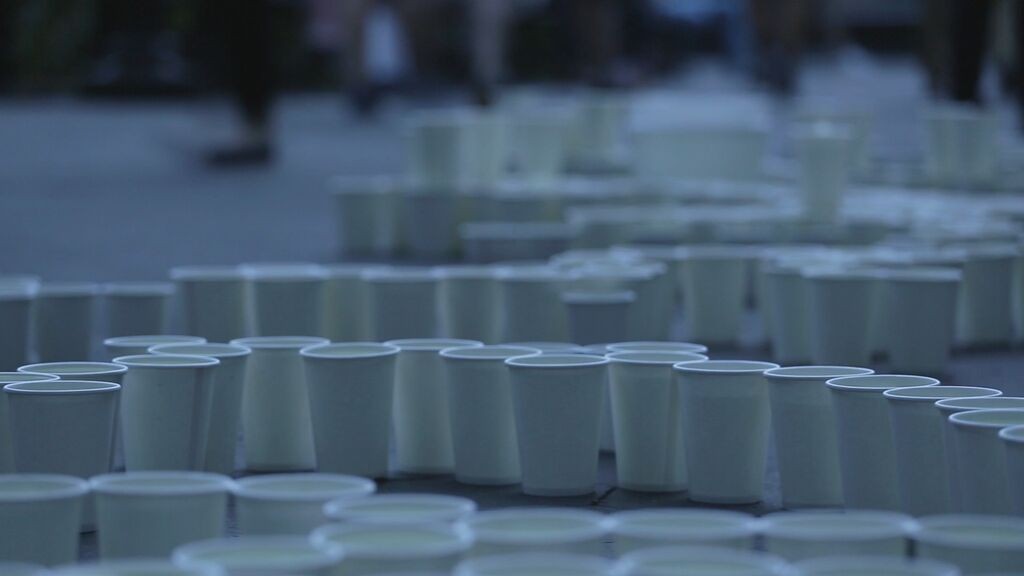
The day continues on like this until 8:30 when we begin the break down. A wave of fresh volunteers arrive. It’s dark now, and we shine a large light onto the cups to see. We pour the water into the earth. Then I begin shoving the cups into black trash bags. It is late. The cups collapse and bend. I look down at what the project has become. Beautiful, brilliant cups, filled with water. Brief representations of life, respected and built by strangers, thrust unceremoniously into five black body bags. I can still feel each cup inside; for a moment, it was a person. Water stains the ground. It looks like blood. I start to cry.
This is the moment when the entire installation becomes real. When I understand just a fraction of the loss and disgusting disrespect for human life. Some may argue that art should do more than just echo reality. To me, I needed to hear the echo first, before I could think of a response.
Friends of mine help me carry the bags to the trash cans. I am still crying as they try to force one of the bags into the can. It won’t fit. They place their hands on the bags and push the cups to make the can close. The cups are still bodies to me, struggling to fit into a trash can.
Two boys have followed us. “Why won’t you recycle them?” they ask.
“Because,” I say for the hundredth time, “it’s a reflection of the way in which our government views these lives as disposable, as waste.”
“But if you want to do some good in the world, you can’t forget about the little things, like recycling. Why are you bringing more negativity into the world? Why not make something beautiful?” they ask me.
But art is not about making something beautiful, it is about saying something true. His distress over wasted paper strikes me as funny. He has forgotten completely what these bags represent.
We place the last two bags next to a mound of trash. Light from the street lamps reflects off the creases in the plastic. As we walk away they become indistinguishable from the other bags of waste.
Black trash bags and a ride across the Williamsburg Bridge. A return to a tiny room. My eyes are bloodshot, my heart is weary from conversation. I wanted to make a piece that broke the passive pattern of the everyday, that brought reality of our country’s actions into our deeply sheltered lives in way that was unavoidable. The purpose of this project was simple: to disrupt space. I wonder if a few thousand cups can accomplish the shaking of a psyche. Or what it would take to open the minds of a nation. My friends are baffled at my distress. “Thousands of people came!” they tell me. “You’re a hashtag!”
And I am.
What does it take to make art that is not so easily digestible? What does it mean to be so easily consumed and shared with passers-by?
By 1am I am asleep. I have absorbed all I can of the world today; it hurts too much to stay awake.
Sonia Mena is a Sarah Lawrence graduate from California.
Her website: http://sonia-luz.com/electroluminescence-our-film
Photo credits according to appearance: Robert Helman (photos 1 & 3), Charlie Cole (photos 2 & 4)
Electroluminescence: A Disruption of Space
